
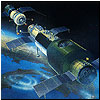

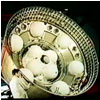
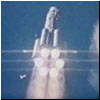
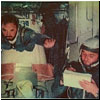
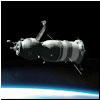
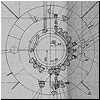


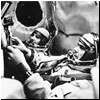
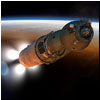
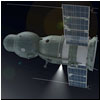
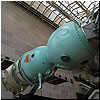
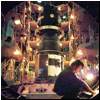
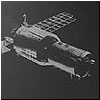
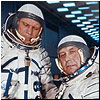
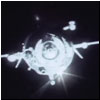
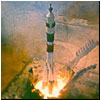
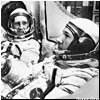
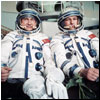

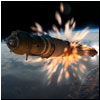
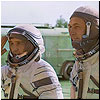

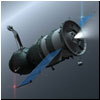
|
The Salyut era: First space stations
During the 1970s, the USSR launched a series of progressively sophisticated orbital laboratories serving as habitats for increasingly lenghty crew visits. They were preparing the foundation for permanent presence of humans in the Earth's orbit.
Previous chapter: Soviet lunar program

Key figures in the Soviet space program attending launch in Tyuratam in the mid 1970s (left to right): cosmonauts Georgy Beregovoy and Vladimir Shatalov, Designer General of NPO Energia Valentin Glushko, Minister of General Machine-building Sergey Afanasiev, Director of NPO Energia's ZEM experimental plant Konstantin Vachnadze and General Kerim Kerimov, the Chairman of the State Commission. Photo-collage by Anatoly Zak
During the 1960s, multiple organizations within the Soviet rocket industry studied projects of space stations, primarily with military goals. The most advanced was the Almaz project at the TsKBM design bureau in Reutov, which entered the full-scale development phase, despite considerable technical and political challenges. In 1969, the rival TsKBEM bureau in Podlipki convinced the Kremlin to endorse its own "crash" development of a "civilian" space station based on Almaz. What would become the Salyut space station program aimed to run in parallel with the lunar exploration and to pave the way to the construction of large permanent settlements in the Earth's orbit.
The USSR begins enduring space station program
Faced with the loss of the Moon Race in 1969, Soviet space strategists conceived a detour of the national human space flight effort to a less expensive but what would turn out to be a lasting effort — the development of a long-term habitat in space.
Building the first Salyut
Conceived, designed and assembled in merely 16 months, Salyut-1 was the product of a three-shift, no-days-off working marathon and the epitome of improvisation. Many design decisions were made right “in the field” during the actual assembly of the station, with leading engineers keeping round-the-clock vigil at the Khrunichev production plant.
Design of the first Salyut space station
The Salyut space station, identified in the industrial documentation as 17K, structurally consisted of a transfer compartment with a diameter of 2.1 meters, followed by the main work section, in turn containing a science instrument compartment, and closed up with an instrument section.
The USSR orbits its first space station
On April 19, 1971, at 04:40 Moscow Time, a three-stage UR-500K (Proton) rocket lifted off from the "Right" pad at Site 81 in Tyuratam and a few minutes later successfully delivered into orbit the first 17K space station (No. 12101). Unknown to the world, the name Zarya (sunrise) had been painted on its body, however the official Soviet media announced it as Salyut-1.
The USSR launches first space station crew
Four days after the Salyut space station entered orbit, the first crew was also on its way. After one aborted launch attempt, the Soyuz-10 transport ship lifted off with three cosmonauts in early hours of April 23, 1971, and reached the station the following day, but then ran into a string of potentially dangerous problems just inches away from its destination.
Soyuz-11 begins a fateful expedition to Salyut
On June 6, 1971, three Soviet cosmonauts, assigned to the flight at the last minute, departed Earth aboard the Soyuz-11 spacecraft for a record-breaking month-long flight aboard the Salyut space station.
Soyuz-11 crew lost at landing
On June 30, 1971, the three members of the Soyuz-11 crew lost their lives just minutes from landing when their Descent Module suddenly depressurized on its way back to Earth from the Salyut orbital laboratory.
Kosmos-496: Fixing Soyuz-11 flaws
On June 26, 1972, the Soviet space program made its first major step on a difficult road to recovery from the Soyuz-11 disaster a year earlier. The upgraded version of the 7K-T vehicle orbited the Earth without crew in the autonomous flight under name Kosmos-496.
DOS-7K No. 2: A failed Salyut
On July 29, 1972, the USSR attempted to launch a second copy of the Salyut space station, however, its UR-500K (Proton) rocket failed to reach orbit, so the mission was never publicly announced.
Salyut space station gets first major upgrade (INSIDER CONTENT)
Based on the very mixed experience in launching and operating the first two Salyut space stations in 1971 and 1972, Soviet engineers at the TsKBEM design bureau built a second pair of orbital labs internally known as DOS-7K No. 3 and No. 4. Despite their designations, they differed significantly from their two predecessors.
DOS-7K No. 3: Skylab's challenger
On May 11, 1973, the USSR launched its fourth space station and the first major upgrade of the original Salyut design, just days ahead of the American Skylab. The 19-ton Soviet lab reached orbit as planned, but an immediate crisis put Soviet engineering and mission control teams to a severe test... Today, it is often only an asterisk in history books, but in 1973, the launch of DOS-3 produced a political earthquake across the Soviet space program and even got the KGB involved.
Kosmos-573: Re-confirming Soyuz fixes
On June 15, 1973, a heavily modified version of the Soyuz 7K-T spacecraft went into orbit without crew or much publicity on its second mission to ensure that all the lessons from the fatal Soyuz-11 accident in 1971 had been learned. In addition, the test flight sought to resolve problems encountered during the ill-fated launch of a Salyut space station a month earlier.
Soyuz-12: USSR resumes crew missions after deadly accident
In September 1973, the Soyuz-12 spacecraft carried two cosmonauts on a test mission of the new crew vehicle variant modified after the loss of three cosmonauts aboard Soyuz-11 more than two years earlier.
Kosmos-613: Soyuz flies a two-month endurance mission
From Nov. 30, 1973, until Jan. 28, 1974, a Soyuz spacecraft without crew secretly orbited the Earth, testing the limits of its onboard systems and setting a new record for its autonomous mission.
Soyuz-13 flies pioneering astronomy mission
In December 1973, two cosmonauts launched into space aboard a custom-built Soyuz-13 spacecraft, carrying the Orion-2 telescope for astrophysical observations. During the eight-day flight, the overworked crew collected a wealth of ultraviolet data from mysterious and little-known objects in the Universe.
Soyuz 7K-TM variant for the US-Soviet joint mission
A specialized version of the Soyuz spacecraft originally known as 7K-TM was custom-designed for the joint mission with the US Apollo spacecraft in 1975. It was equipped with a new type of a docking port dubbed APAS for Androgynous Peripheral Attach System.
Kosmos-638: First rehearsal of a joint mission with Apollo (INSIDER CONTENT)
On April 3, 1974, the USSR launched an unpiloted test version of a modified Soyuz vehicle, which it hoped to eventually use for an orbital docking with the American Apollo spacecraft. Despite the international nature of the project, the introduction of the new variant was shrouded in usual Soviet secrecy and was barely documented in history books.
Soyuz-14: The USSR launches first military station crew
On July 3, 1974, the Soyuz-14 mission carried what was announced as an expedition to the newly launched Salyut-3 space station. In fact, it was a specialized military team heading to the Almaz OPS-2 orbital observation outpost publicly camouflaged behind the civilian space station program. For the first time, a piloted military orbiter armed with a self-defense gun and an array of reconnaissance equipment operated in space.
The USSR develops new variant of the Soyuz spacecraft — 7KS
Fast-paced upgrades of the Soyuz spacecraft in the early 1970s included work on the most-advanced version of ship at the time, called 7K-S, initially conceived for the military. It never reached operational status but paved the way for the 7K-ST variant (Soyuz-T) which became the workhorse of the Russian piloted space program in the 1980s.
The USSR launches Soyuz 7K-S variant (INSIDER CONTENT)
On Aug. 6, 1974, the USSR secretly launched an experimental version of the Soyuz spacecraft that opened a years-long flight test program that would lead to the Soyuz-T variant. The first mission, which lasted two days, was announced under the cover name Kosmos-670, but its true objectives were not acknowledged until the end of the Soviet period.
The USSR tests Soyuz for joint mission with the US (INSIDER CONTENT)
The original test flight program of the Soyuz 7K-TM variant, developed for the Apollo-Soyuz docking mission, envisioned one unpiloted launch and two dress rehearsal missions with cosmonauts onboard. However, numerous technical problems and equipment delays hampering the first test flight in April 1974 prompted Soviet officials to add another pilotless launch in August of the same year. It lifted off without much fanfare under the cover name Kosmos-672 on Aug. 12, 1974.
The Soviet military crew fails to reach its orbital post
On Aug. 26, 1974, the USSR launched the second expedition to the Almaz OPS-2 military space station, operating in Earth's orbit under the cover name Salyut-3. However, commander Gennady Sarafanov and flight engineer Lev Demin failed to dock their Soyuz-15 spacecraft to the outpost, narrowly avoiding a high-speed collision. The crew then urgently headed home after just two days in orbit.
Salyut-4: Finally a breakthrough
On Dec. 26, 1974, the USSR launched its sixth attempt to establish habitable base in orbit, taking into the account four years of very difficult experience in launching and operating such complex vehicles. This time, the space station, publicly announced as Salyut-4, worked well, setting the stage for a very busy year in space.
First expedition on Salyut-4
On Jan. 11, 1975, just three weeks after the launch of the Salyut-4 space station, the USSR orbited its first crew slated to occupy the outpost for nearly a month. During their expedition, members of the Soyuz-17 crew overcome a series of technical challenges to conduct pioneering research in orbit.
Cosmonauts escape a close call at launch
On April 5, 1975, the second crew heading to Salyut-4 went through a near-death experience when their rocket failed just short of orbital velocity, triggering dangerous fall back to Earth and a risky recovery operation in the mountainous terrain near the hostile border with China.
Second expedition to Salyut-4
The two-month trip of the Soyuz-18 crew to a space station in 1975, which broke a Soviet flight-duration record, is also widely credited with setting standards and procedures for progressively longer stays of Soviet cosmonauts aboard Earth-orbiting outposts for years to come.
Apollo-Soyuz project, ASTP
In July 1975, the Soyuz-19 spacecraft with two cosmonauts onboard and the US Apollo vehicle with three NASA astronauts conducted a successful rendevous in the orbit around the Earth, becoming a symbol of a short-lived detente period in the Cold War.
The USSR repeats the Soyuz 7K-S flight test (INSIDER CONTENT)
On Sept. 29, 1975, the second experimental version of the Soyuz spacecraft, later known as Soyuz T, secretly entered orbit without a crew. The mission was announced under the cover name Kosmos-772, but its details remain largely unknown until this day.
Soviet and Russian
space station launches:
| Salyut-1 |
|
TsKBEM |
|
1
|
Oct.
11, 1971 |
The
first crew docked but was not able to enter the station. |
| Unannounced |
DOS-2 |
TsKBEM |
July
29, 1972 |
|
|
Did
not reach the orbit due to the Proton launcher
failure. |
| Salyut-2 |
|
TsKBM |
April
3, 1973 |
|
May
28, 1973 |
Depressurized
after being hit by debris from the exploded Proton upper stage. |
| Kosmos-557 |
|
TsKBEM |
May
11, 1973 |
|
May
1973 |
A control
system failure caused the drainage of the onboard fuel. |
| Salyut-3 |
|
TsKBM |
June
25, 1974 |
1
|
|
|
| Salyut-4 |
|
TsKBEM |
Dec.
26, 1974 |
2 |
Feb.
3, 1977 |
|
| Salyut-5 |
|
TsKBM |
June
22, 1976 |
2
|
August
8, 1977 |
|
| Salyut-6 |
DOS-5 |
NPO
Energia |
Sept.
29, 1977 |
16 |
July
28, 1982 |
The
first crew was not able to dock with the station |
| Salyut-7 |
DOS-5-2 |
NPO
Energia |
April
19 , 1982 |
9 |
Feb.
7, 1991 |
|
| Mir |
DOS-7 |
NPO
Energia |
Feb.
20, 1986 |
|
|
Core module of the Mir space station |
| Zvezda |
DOS-8 |
RKK
Energia |
July
12, 2000 |
|
In orbit |
A service module for the International Space Station, ISS |
Soviet
launches related to space station projects and solo Soyuz flights in 1971-1985:
| Salyut-1 |
|
|
|
|
|
| Soyuz-10 |
7K-T No. 31 |
April
23, 1971 |
April
24, 1971 |
Vladimir
Shatalov
Aleksei Yeliseyev
Nikolai Rukavishnikov |
Docked
to Salyut-1 on April 24. Failed to transfer into the station |
| Soyuz-11 |
7K-T No. 32 |
June
6, 1971 |
|
Georgy
Dobrovolskiy
Vladislav Volkov
Viktor Patsaev |
Docked
to Salyut-1 from June 7 to June 29. The crew is lost due to depressurization
during landing. |
| Kosmos-496 |
7K-T No. 33A |
June
26, 1972 |
July
1, 1972 |
|
A solo flight testing upgrades after the Soyuz-11 accident |
| Unannounced |
DOS-7K No. 2 |
July
29, 1972 |
|
|
Did
not reach orbit due to a Proton
launcher failure |
| Salyut-2 |
|
April
3, 1973 |
|
|
Depressurized
after being hit by debris from an exploded Proton upper stage |
| Kosmos-557 |
DOS-7K No. 3 |
May
11, 1973 |
|
|
Control
system failure caused loss of onboard propellant |
| Kosmos-573 |
7K-T No. 36 |
June
15, 1973 |
June
17, 1973 |
|
Unpiloted solo test flight |
| Soyuz-12 |
7K-T No. 37 |
Sept. 27, 1973 |
Sept. 29, 1973 |
Vasily Lazarev
Oleg Makarov |
7K-T test flight |
| Kosmos-613 |
7K-T No. 34A |
Nov.
30, 1973 |
Jan.
28, 1974 |
|
7K-T
test flight |
| Soyuz-13 |
7K-T No. 33 |
Dec.
18, 1973 |
Dec.
26, 1973 |
Petr
Klimuk
Valentin Lebedev |
|
| Kosmos-638 (Insider Content) |
7K-TM
No. 71 |
April
3, 1974 |
April
13, 1974 |
|
Preparation for Soyuz-Apollo mission |
Kosmos-656
(Insider Content) |
7K-T
No. 61 |
May
27, 1974 |
May
29, 1974 |
|
7K-T
test version for the Almaz project |
| Salyut-3 |
|
June
25, 1974 |
Jan. 25, 1975 |
|
|
| Soyuz-14 |
7K-T No. 62 |
July
3, 1974 |
July
19, 1974 |
Pavel
Popovich
Yuri Artyukhin |
Docked
to Salyut-3 from July 5 to July 19 |
| Kosmos-670 (Insider Content) |
7K-S
No. 1L |
Aug.
6, 1974 |
Aug.
8, 1974 |
|
|
| Kosmos-672 (Insider Content) |
7K-TM
No. 72 |
Aug.
12, 1974 |
Aug.
18, 1974 |
|
Preparation for Soyuz-Apollo mission |
| Soyuz-15 |
7K-T No. 63 |
August
26, 1974 |
Aug.
28, 1974 |
Gennady
Sarafanov
Lev Demin |
Failed
to dock with Salyut-3 due to a problem with the Igla
rendezvous system |
| Soyuz-16 |
7K-TM No. 73 |
Dec.
2, 1974 |
Dec.
8, 1974 |
Anatoly
Filipchenko
Nikolai Rukavishnikov |
Solo test flight preparing the Apollo-Soyuz joint mission |
| Salyut-4 |
|
Dec.
26, 1974 |
|
|
|
| Soyuz-17 |
7K-T No. 38 |
Jan.
11, 1975 |
Feb.
9, 1975 |
Aleksei Gubarev
Georgy Grechko |
Docked
to Salyut-4 from Jan. 12 to Feb. 9, 1975 |
| Soyuz-18-1 |
7K-T No. 39 |
April
5, 1975 |
|
Vasily
Lazarev
Oleg Makarov |
Suborbital
flight due to third stage failure |
| Soyuz-18 |
7K-T No. 40 |
May
24, 1975 |
July
26, 1975 |
Petr
Klimuk
Vitaly Sevastyanov |
Docked
to Salyut-4 from May 26 to July 26. |
| Soyuz-19 |
7K-TM No. 75 |
July
15, 1975 |
July
21, 1975 |
Aleksei
Leonov
Valery Kubasov |
Docked
with Apollo July 17-19. |
| Kosmos-772 (Insider Content) |
7K-S
No. 2L |
Sept.
29, 1975 |
Oct.
2, 1975 |
|
7K-S/ST
(Soyuz T) test flight |
| Soyuz-20 |
7K-T No. 64 |
Nov.
17, 1975 |
Feb.
16, 1976 |
|
Docked
to Salyut-4 from Nov. 19, 1975 to Feb. 16, 1976 |
| Salyut-5 |
|
June
22, 1976 |
|
|
|
| Soyuz-21 |
7K-T |
July
6, 1976 |
Aug
24, 1976 |
Boris
Volynov
Vitaly Zholobov |
Docked
to Salyut-5 from July 7 to August
24. |
| Soyuz-22 |
7K-T |
Sept.
15, 1976 |
Sept.
23, 1976 |
Valery
Bykovsky
Vladimir Aksenov |
Solo
remote-sensing flight at 64.7-degree orbit |
| Soyuz-23 |
7K-T |
Oct.
14, 1976 |
Oct.
16, 1976 |
Vyacheslav
Zudov
Valery Rozhdestvensky |
Failed
to dock to Salyut-5. Splashed down
in Lake Tengiz |
| Kosmos-869 |
7K-S
No. 3L |
Nov.
29, 1976 |
Dec.
17, 1976 |
|
7K-S/ST
(Soyuz T) test flight |
| Soyuz-24 |
7K-T |
Feb.
7, 1977 |
Feb.
25, 1977 |
Viktor
Gorbatko
Yury Glazkov |
Docked
to Salyut-5 from Feb. 8 to Feb. 25 |
| Kosmos-929 |
|
July
17, 1977 |
Aug.
16, 1977 (unmanned capsule) |
|
TKS
test. Deorbited Feb. 2, 1978 |
| Salyut-6 |
DOS-7K No. 5-1 |
Sept.
29, 1977 |
|
|
|
| Soyuz-25 |
7K-T |
Oct.
9, 1977 |
Oct.
11, 1977 |
Vladimir
Kovalenok
Valery Ryumin |
Failed
to dock to Salyut-6 |
| Soyuz-26 |
7K-T |
Dec.
10, 1977 |
Jan.
16, 1978 |
Yury
Romanenko
Georgy Grechko
(landed on Soyuz-27) |
Docked
to Salyut-6 from Dec. 11 to Jan. 16. |
| Soyuz-27 |
7K-T |
Jan.
10, 1978 |
March
16, 1978 |
Vladimir
Dzhanibekov
Oleg Makarov
(landed on Soyuz-26) |
Docked
to Salyut-6 from Jan. 11 to March 16. |
| Progress-1 |
|
Jan.
20, 1978 |
|
|
Docked
to Salyut-6 from Jan. 22 to Feb. 6. Deorbited Feb. 8 |
| Soyuz-28 |
7K-T |
March
3, 1978 |
March
10, 1978 |
Aleksei
Gubarev
Vladimir Remek |
Docked
to Salyut-6 from March 3 to March 10. |
| Kosmos-1001 |
7K-ST
No. 4L |
April
4, 1978 |
April
15, 1978 |
- |
7K-ST
(Soyuz T) test flight |
| Soyuz-29 |
7K-T |
June
15, 1978 |
Sept.
3, 1978 |
Vladimir
Kovalenok
Aleksandr Ivanchekov (landed on Soyuz 31) |
Docked
to Salyut-6 from June 16 to Sept 3. |
| Soyuz-30 |
7K-T |
June
27, 1978 |
July
5, 1978 |
Peter
Klimuk
Miroslaw Hermaszewski |
Docked
to Salyut-6 from June 28 to July 5. |
| Progress-2 |
|
July
7, 1978 |
|
|
Docked
to Salyut-6 from July 9 to Aug. 2. Deorbited Aug. 4 |
| Progress-3 |
|
Aug.
8, 1978 |
|
|
Docked
to Salyut-6 from Aug. 10 to Aug. 21. Deorbited Aug. 24 |
| Soyuz-31 |
7K-T |
Aug.
26, 1978 |
Nov.
2, 1978 |
Valery
Bykovskiy
Sigmund Jähn
(landed on Soyuz 29) |
Docked
to Salyut-6 from Aug 27 to Nov. 11. Redocked Sept. 7 |
| Progress-4 |
|
Oct.
4, 1978 |
|
|
Docked
to Salyut-6 from Oct. 6 to Oct. 24. Deorbited Oct. 26 |
| Kosmos-1074 |
7K-ST
No. 5L |
Jna.
31, 1979 |
April
1, 1979 |
|
7K-ST
(Soyuz T) test flight |
| Soyuz-32 |
7K-T |
Feb.
25, 1979 |
June
13, 1979 |
Vladimir
Lyakhov
Valery Ryumin
(landed on Soyuz 34)
|
Docked
to Salyut-6 from Feb. 26 to June 13. Landed unmanned |
| Progress-5 |
|
March
12, 1979 |
|
|
Docked
to Salyut-6 from March 14 to April 3. Deorbited April 5 |
| Soyuz-33 |
7K-T |
April
10, 1979 |
April
12, 1979 |
Nikolai
Rukavishnikov,
Georgy Ivanov (Kakalov) |
Failed
to dock with Salyut-6 |
| Progress-6 |
|
May
13, 1979 |
|
|
Docked
to Salyut-6 from May 15 to June 8. Deorbited June 10 |
| Soyuz-34 |
7K-T |
June
6, 1979 |
Aug.
19, 1979 |
launched without crew |
Docked
to Salyut-6 from June 7 to Aug. 19. Redocked June 14 |
| Progress-7 |
|
June
28, 1979 |
|
|
Docked
to Salyut-6 from June 30 to July 18. Deorbited July 20 |
| Soyuz
T |
7K-ST
No. 6L |
Dec.
16, 1979 |
March
26, 1980 |
|
Docked
to Salyut-6 from Dec. 19 to March 24. |
| Progress-8 |
- |
March
27, 1980 |
|
|
Docked
to Salyut-6 from March 29 to April 25. Deorbited April 26 |
| Soyuz-35 |
7K-T |
April
9, 1980 |
June
3, 1980 |
Leonid
Popov,
Valery Ryumin (landed on Soyuz 37) |
Docked
to Salyut-6 from April 10 to June 3. |
| Progress-9 |
|
April
27, 1980 |
|
|
Docked
to Salyut-6 from April 29 to May 20. Deorbited May 22 |
| Soyuz-36 |
7K-T |
May
26, 1980 |
July
31, 1980 |
Valery
Kubasov
Bertalan Farkas
(landed on Soyuz 35) |
Docked
to Salyut-6 from May 27 to July 31. Redocked on June 4. |
| Soyuz
T-2 |
7K-ST
No. 7L |
June
5, 1980 |
June
9, 1980 |
Yuri
Malushev
Vladimir Aksenov |
Docked
to Salyut-6 from June 6 to June 9. |
| Progress-10 |
|
June
29, 1980 |
|
|
Docked
to Salyut-6 from July 1 to July 18. Deorbited July 19 |
| Soyuz-37 |
7K-T |
July
23, 1980 |
Oct.
11, 1980 |
Viktor
Gorbatko
Pham Tuan
(landed on Soyuz 36) |
Docked
to Salyut-6 from July 24 to Oct. 11. (Redocked on Aug. 1) |
| Soyuz-38 |
7K-T |
Sept.
18, 1980 |
Sept.
26, 1980 |
Yuri
Romanenko
Arnaldo Tomayo Mendes |
Docked
to Salyut-6 from Sept. 19 to Sept. 26. |
| Progress-11 |
|
Sept.
28, 1980 |
|
|
Docked
to Salyut-6 from Sept. 30 to Dec. 9. Deorbited Dec. 11 |
| Soyuz
T-3 |
7K-ST
No. 8L |
Nov.
27, 1980 |
Dec.
12, 1980 |
Leonid
Kizim
Oleg Makarov
Gennady Strekalov |
Docked
to Salyut-6 from Nov. 28 to Dec. 12. |
| Progress-12 |
|
Jan.
24, 1981 |
|
|
Docked
to Salyut-6 from Jan. 26 to March 19. Deorbited March 21 |
| Soyuz
T-4 |
|
March
12, 1981 |
May
26, 1981 |
Vladimir
Kovalenok,
Viktor Savinukh |
Docked
to Salyut-6 from March 13 to May 26. |
| Soyuz-39 |
7K-T |
March
22, 1981 |
March
30, 1981 |
Vladimir
Dzhanibekov
Zhugderdemidiyn Gurragchaa |
Docked
to Salyut-6 from March 23 to March 30. |
| Kosmos-1267 |
|
April
21, 1981 |
May
24, 1981 (unmanned capsule) |
|
Docked
to Salyut-7 June 19. Deorbited with Salyut-6 |
| Soyuz-40 |
7K-T |
May
14, 1981 |
May
22, 1981 |
Leonid
Popov,
Dumitru Prunariu |
Docked
to Salyut-6 from May 15 to May 22. |
| Salyut-7 |
DOS-5-2 |
April
19, 1982 |
|
|
|
| Soyuz
T-5 |
7K-ST |
May
13, 1982 |
Aug.
27, 1982 |
Anatoly
Berezovoy,
Valentin Lebedev (returned on Soyuz T-7) |
Docked
to Salyut-7 from May 14 to Aug. 27. |
| Progress-13 |
|
May
23, 1982 |
|
|
Docked
to Salyut-7 from May 25 to June 4. Deorbited June 6 |
| Soyuz
T-6 |
7K-ST |
June
24, 1982 |
July
2, 1982 |
Vladimir
Dzhanibekov,
Aleksandr Ivanchenkov,
Jan Lou Chrétien |
Docked
to Salyut-7 from June 25 to July 2. |
| Progress-14 |
|
July
10, 1982 |
|
|
Docked
to Salyut-7 from July 12 to Aug. 11. Deorbited Aug. 13 |
| Soyuz
T-7 |
7K-ST |
Aug.
19 , 1982 |
Dec.
10, 1982 |
Leonid
Popov,
Aleksand Serebrov,
Svetlana Savitskaya (landed on Soyuz T-5) |
Docked
to Salyut-7 from Aug. 20 to Dec. 10 |
| Progress-15 |
|
Sept.
18, 1982 |
|
|
Docked
to Salyut-7 from Sept. 20 to Oct. 14. Deorbited Oct. 16 |
| Progress-16 |
|
Oct.
31, 1982 |
|
|
Docked
to Salyut-7 from Nov. 2 to Dec. 13. Deorbited Dec. 14 |
| Kosmos-1443 |
|
March
2, 1983 |
Aug.
23, 1983 (unmanned capsule) |
|
Docked
to Salyut-7 from March 10 Aug. 14. Deorbited Sept. 19 |
| Soyuz
T-8 |
7K-ST |
April
20, 1983 |
April
22, 1983 |
Vladmir
Titov,
Aleksandr Serebrov,
Gennady Strekalov |
Failed
to dock to Salyut-7. |
| Soyuz
T-9 |
7K-ST |
June
27, 1983 |
Nov.
23, 1983 |
Vladimir
Lyakhov,
Aleksandr Aleksandrov |
Docked
to Salyut-7 from June 28 to Nov. 23 |
| Progress-17 |
|
Aug.
17, 1983 |
|
|
Docked
to Salyut-7 from Aug. 19 to Sept. 17. Deorbited Sept. 18 |
| Soyuz
T |
7K-ST
No. 16L |
Sept.
26, 1983 |
|
Vladimir
Titov,
Gennady Strekalov |
|
| Progress-18 |
|
Oct.
20, 1983 |
|
|
Docked
to Salyut-7 from Oct. 22 to Nov. 13. Deorbited Nov. 16 |
| Soyuz
T-10 |
7K-ST |
Feb. 8, 1984 |
April 11, 1984 |
Leonid
Kizim,
Vladimir Soloviev,
Oleg Atkov |
Docked
to Salyut-7 from Feb. 9 to April 11 |
| Progress-19 |
|
Feb.
20, 1984 |
|
|
Docked
to Salyut-7 from Feb. 22 to March 31. Deorbited April 1 |
| Soyuz
T-11 |
|
April 3, 1984 |
Oct. 2, 1984 |
Yuri
Malyshev,
Gennady Strekalov,
Rakesh Sharma (landed on Soyuz T-10) |
Docked
to Salyut-7 from April 4 to - Oct. 2 Redocked on April 13 |
| Progress-20 |
|
April
15, 1984 |
|
|
Docked
to Salyut-7 from April 17 to May 6. Deorbited May 7 |
| Progress-21 |
|
May
7, 1984 |
|
|
Docked
to Salyut-7 from May 10 to May 26. Deorbited May 26 |
| Progress-22 |
|
May
28, 1984 |
|
|
Docked
to Salyut-7 from May 30 to July 15. Deorbited July 15 |
| Soyuz
T-12 |
|
July 17, 1984 |
July 29, 1984 |
Vladmir
Dzhanibekov,
Svetlana Savitskaya,
Igor Volk |
Docked
to Salyut-7 from July 18 to July 29 |
| Progress-23 |
|
Aug.
14, 1984 |
|
|
Docked
to Salyut-7 from Aug. 16 to Aug. 26. Deorbited Aug. 28 |
| Soyuz
T-13 |
|
June 6, 1985 |
Sept. 26, 1985 |
Vladimir
Dzhanibekov,
Viktor Savinykh (landed on Soyuz T-14) |
Docked
to Salyut-7 from June 8 to Sept. 25 |
| Progress-24 |
|
June
21, 1985 |
|
|
Docked
to Salyut-7 from June 23 to July 15. Deorbited July 15 |
| Kosmos-1669 |
|
July
16, 1985 |
|
|
Docked
to Salyut-7 from July 18 Aug. 28. Deorbited Aug. 30 |
| Soyuz
T-14 |
|
Sept. 17, 1985 |
Nov. 21, 1985 |
Vladimir
Vasyutin,
Georgy Grechko, (landed on Soyuz T-13)
A. Volkov |
Docked
to Salyut-7 from Sept. 18 to Nov. 21 |
| Kosmos-1686 |
|
Sept. 27, 1985 |
|
|
Docked
to Salyut-7 on Oct. 2, 1985 |
Next chapter: Mir space station
|


|